By @JonathanYarwood – PGA Master Professional
The shortest club in the bag also happens to be one of the most important – it’s no secret that the pros practise this part of the game more than anything else. Whatever your handicap, the quickest route to lower scores is to go out and improve the quality of your putting stroke. This quick lesson will help…
The case for the ‘long-V’
Arms hang for pendulum motion
Tour players today tend to work on what I would term a ‘long V’, the arms hanging comfortably to place the hands directly below the sternum. The upper part of each arm is nicely ‘connected’ to the upper body, and this shape – and indeed that connection – is maintained throughout the stroke. The result is a repeating pendulum motion – the most popular type of stroke that we see on tour in modern professional golf.
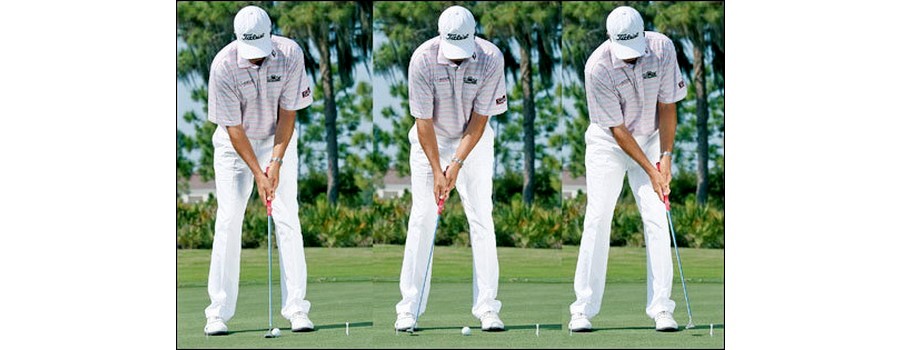
A good set-up places your body, arms and putter in position to initiate a smooth & easy pendulum motion
Notice that the long ‘V’ formed by the arms remains intact throughout, hands passive, while the putterhead remains low to the ground
Let me stress up front that the shoulders rotate slightly in a good putting stroke; they do not rock. They turn slightly back and through, as you can just detect in the sequences you see here and over the page.
Note here how my chest has turned slightly in the finish. This allows the putter to follow the natural arc again, the long V encouraging a taller posture, which in itself encourages a more rotary motion of the shoulders.
When you go out to work on your putting before a game, spend at least 10 minutes thinking abut the structure of your stroke (using the drill you see above and opposite to ingrain that sense of connection and repeatability). Placing two tees in the green as I have done here (above) is a simple first step that reminds you to maintain the length of your stroke, both back and through. That is one of the keys to repeating a fluid rhythm, which is essential when it comes to making solid contact with the ball.
How to really feel the ‘connection’
Trap a towel to keep arms and body ‘together’
All you need to work on ingraining a ‘connected’ putting stroke is a decent sized towel. One that is long enough for you to trap the ends under each arm – just as I have done here. Because in doing that you set up what is probably the best drill with which to groove a pendulum putting stroke (it’s also great for developing the basic chipping action).
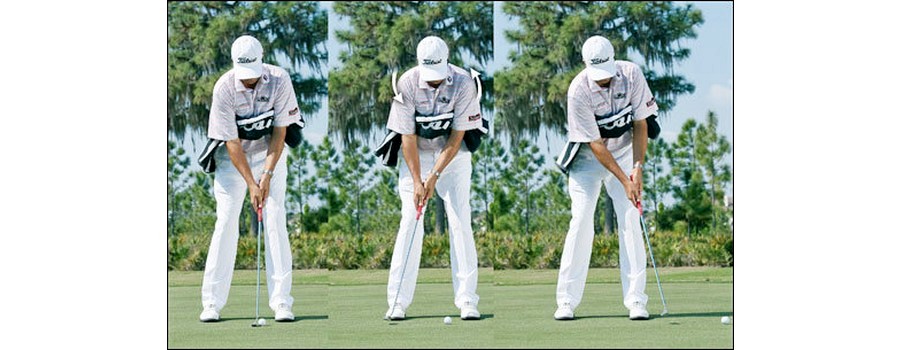
In a good set-up, with the arms extended to form the long ‘V’, sense that the pressure of the upper arms on the chest keeps the towel in place
As the shoulders gently rotate, the unit of the torso & the arms can be seen to work together, producing a perfect pendulum stroke
Note that the chest opens to the target line as the putter is released and the ball sent on its way
Let me emphasize again, the secret to being a good putter lies in the ability to control and repeat a consistent motion, and you will do that effectively when the arms and the upper torso work together as a guiding unit. Trapping the ends of a towel under each arm immediately gives you a feeling of the upper arms being ‘connected’ to the upper chest – and that’s exactly the sensation you want to have throughout the stroke.
Keep that pressure constant to keep the ends of the towel in place. Any tendency for the arms to work independently of the torso (i.e. to ‘splay’ about in the fashion I mentioned earlier) will result in the towel falling free (left below). So that’s a simple but effective training drill that you can rehearse anytime. Out on the course, you can improvise by tucking your shirt sleeves up under your armpits before you get set up to the ball. That’s perfectly legal and gives you the same feeling of connection.
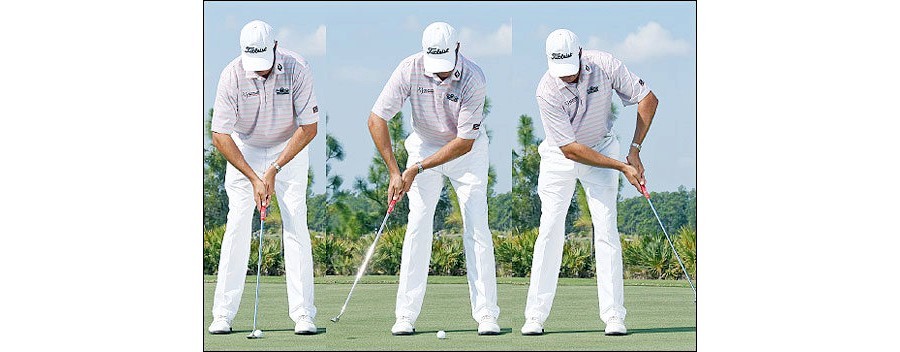
‘Splaying’ the elbows is a common fault and one that leads to inconsistency, as the arms will tend to operate independently of the upper body during the stroke. To remedy the problem, work on achieving the symmetry of the longer ‘V’ in your set-up position (as per the towel drill), the upper part of your arms resting on your upper torso, the shaft of the putter falling nicely in line with your forearms. Have the length & lie of your putter adjusted to accommodate this set-up.
Develop the stability of your right hand/arm
Repetition of this holing-out drill will transform your confidence
Tiger Woods used to be the master of this drill – and he probably still is. (Like the rest of us he is clearly having trouble taking his practice game to the golf course!). But at his best he was devastating from this range and I have stood and watched him hit putts like this, with just his right hand on the grip, and not miss for a good 20 minutes.
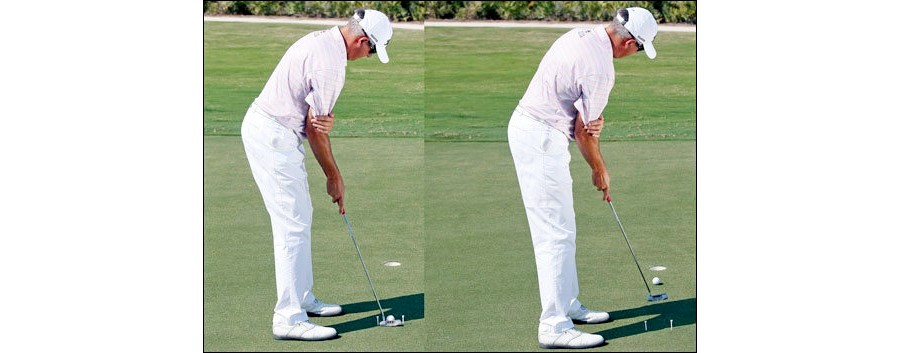
Find a straight three footer, and create a ‘gate’, placing two tees just a little wider apart than the width of your putter-head
The challenge lies in gliding the putter back and through the gate, meeting the ball square-on and rolling it home, centre-cup
To get yourself set up and ready to rehearse this drill, I suggest you start from around three feet or so, and place the tee pegs apart so that there is at least a quarter of an inch clearance on either side of the putter-head. Then, making sure that your feet, hips and shoulders are square to the line of the putt, take the putter with your right hand and steady the right arm with the left hand. You should feel a comfortable connection between the upper part of the right arm and your upper torso, while your right forearm and the shaft of the putter are in ‘sync’. Set yourself a challenge of holing 10 putts in a row, then 20 and so on. You will be amazed at the confidence this gives you – it can transform your holing-out.
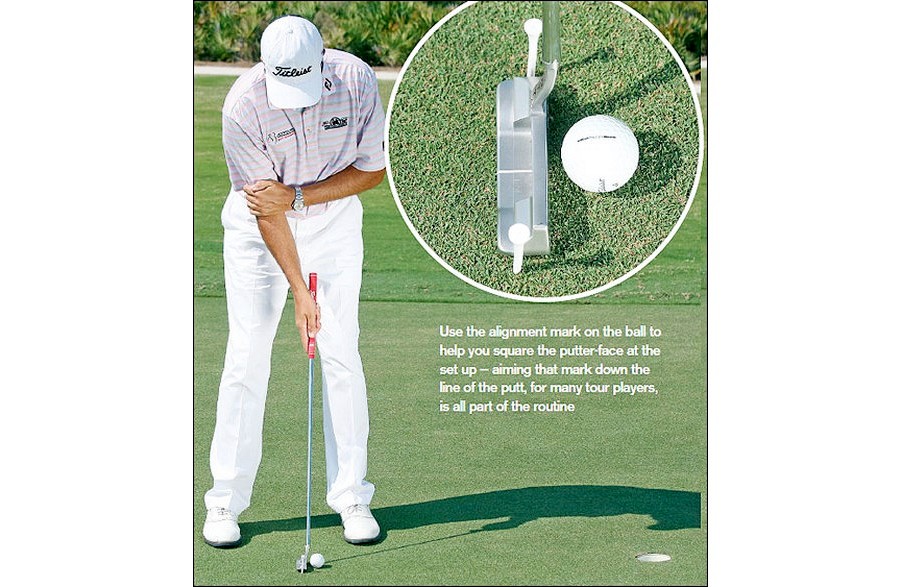
Use the alignment mark on the ball to help you square the putter-face at the set up – aiming that mark down the line of the putt, for many tour players is all part of the routine
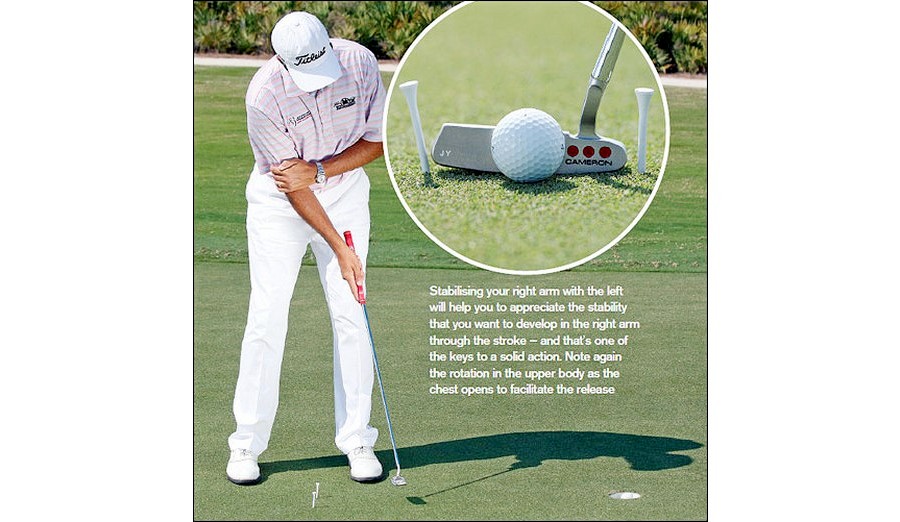
Stabilising your right arm with the left will help you to appreciate the stability that you want to develop in the right arm through the stroke – and that’s one of the keys to a solid action.
Note again the rotation in the upper body as the chest opens to facilitate the release
Originally posted in 2011